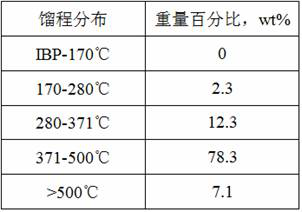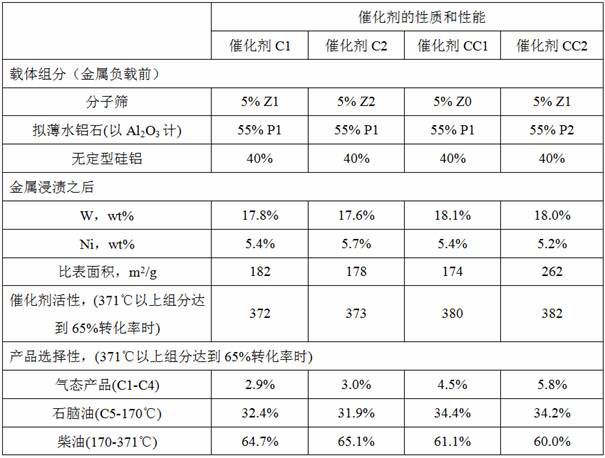A kind of preparation method of hydrocracking catalyst with high light oil selectivity
A hydrocracking and catalyst technology, applied in physical/chemical process catalysts, molecular sieve catalysts, chemical instruments and methods, etc., can solve the problem of low octane number of naphtha
- Summary
- Abstract
- Description
- Claims
- Application Information
AI Technical Summary
Problems solved by technology
Method used
Image
Examples
Embodiment 1
[0032] Embodiment 1: Preparation of Y molecular sieve Z1
[0033] Prepare 2000mL of 3wt% dilute nitric acid solution, add 500g of Y molecular sieve Z0 to it, stir vigorously at 50°C for 4h, settle for 2-3h, pour out most of the upper liquid, centrifuge the remaining solid and a small amount of liquid, and centrifuge the solid Add 250mL deionized water, stir and wash, and centrifuge. Repeat centrifugation and washing for 3 times, and finally the molecular sieve solid obtained by centrifugation is first dried at 150°C for 8 hours, and then calcined at 500°C for 4 hours in an air atmosphere to obtain acid-treated molecular sieve Z1.
Embodiment 2
[0034] Embodiment 2: Preparation of Y molecular sieve Z2
[0035] Prepare 1000mL, 1mol / L ethylenediaminetetraacetic acid (EDTA) ethanol solution, add 200g Y molecular sieve Z0 to it, stir vigorously at room temperature for 4 hours, settle for 2-3 hours, pour out most of the upper liquid, and carry out the remaining solid and a small amount of liquid After centrifugation, the centrifuged solid was added to 200 mL of ethanol, stirred, washed, and centrifuged. Repeat centrifugation and washing for 3 times, and finally the molecular sieve solid obtained by centrifugation is dried in a vacuum oven at 80°C for 6h, and then calcined at 500°C for 4h in an air atmosphere to obtain the treated molecular sieve Z2.
[0036] The properties of commercial Y molecular sieve Z0 and Y molecular sieves Z1 and Z2 prepared in Examples 1 and 2 are compared in Table 1.
[0037] Table 1 Performance comparison of different molecular sieves
[0038]
[0039] Depend on 27According to the character...
Embodiment 3
[0040] Example 3: Preparation of hydrocracking catalyst C1 (Z1+P1 (acid gel index 90%))
[0041] Weigh 110 g of pseudo-boehmite P1 (dry basis, unless otherwise specified, all weights of the following raw materials are dry basis), 80 g of imported amorphous silica-alumina, and 10 g of molecular sieve Z1, and fully mix the three solid powders Finally, add the pre-prepared dilute nitric acid solution (3.3g, 67wt% concentrated nitric acid diluted with 200 g deionized water), knead vigorously for 15 minutes, extrude through a 2.5mm orifice plate, and dry at 120°C for 6h. Calcined in air at 500°C for 4h to obtain the catalyst carrier. Then impregnate the carrier with a mixed aqueous solution of ammonium metatungstate and nickel nitrate in equal volume to load 18% W and 5.4% Ni (theoretical weight), and then dry it at 120°C for 4 hours, then dry it at 500°C in an air atmosphere Calcined for 4h, the resulting catalyst was marked as C1.
[0042] Implementation 4: Preparation of hydro...
PUM
| Property | Measurement | Unit |
|---|---|---|
| specific surface area | aaaaa | aaaaa |
| pore size | aaaaa | aaaaa |
| specific surface area | aaaaa | aaaaa |
Abstract
Description
Claims
Application Information
 Login to View More
Login to View More - R&D
- Intellectual Property
- Life Sciences
- Materials
- Tech Scout
- Unparalleled Data Quality
- Higher Quality Content
- 60% Fewer Hallucinations
Browse by: Latest US Patents, China's latest patents, Technical Efficacy Thesaurus, Application Domain, Technology Topic, Popular Technical Reports.
© 2025 PatSnap. All rights reserved.Legal|Privacy policy|Modern Slavery Act Transparency Statement|Sitemap|About US| Contact US: help@patsnap.com



